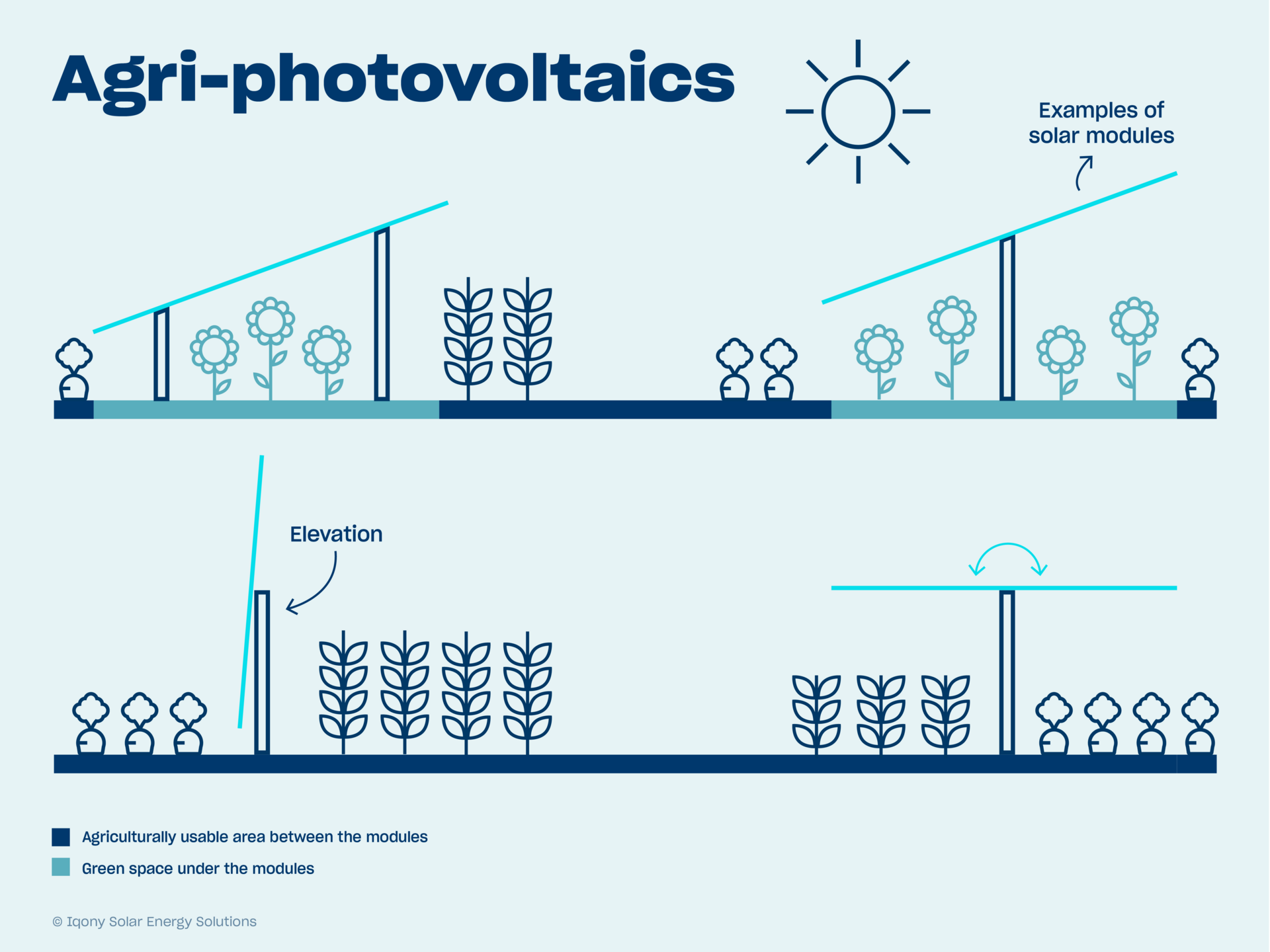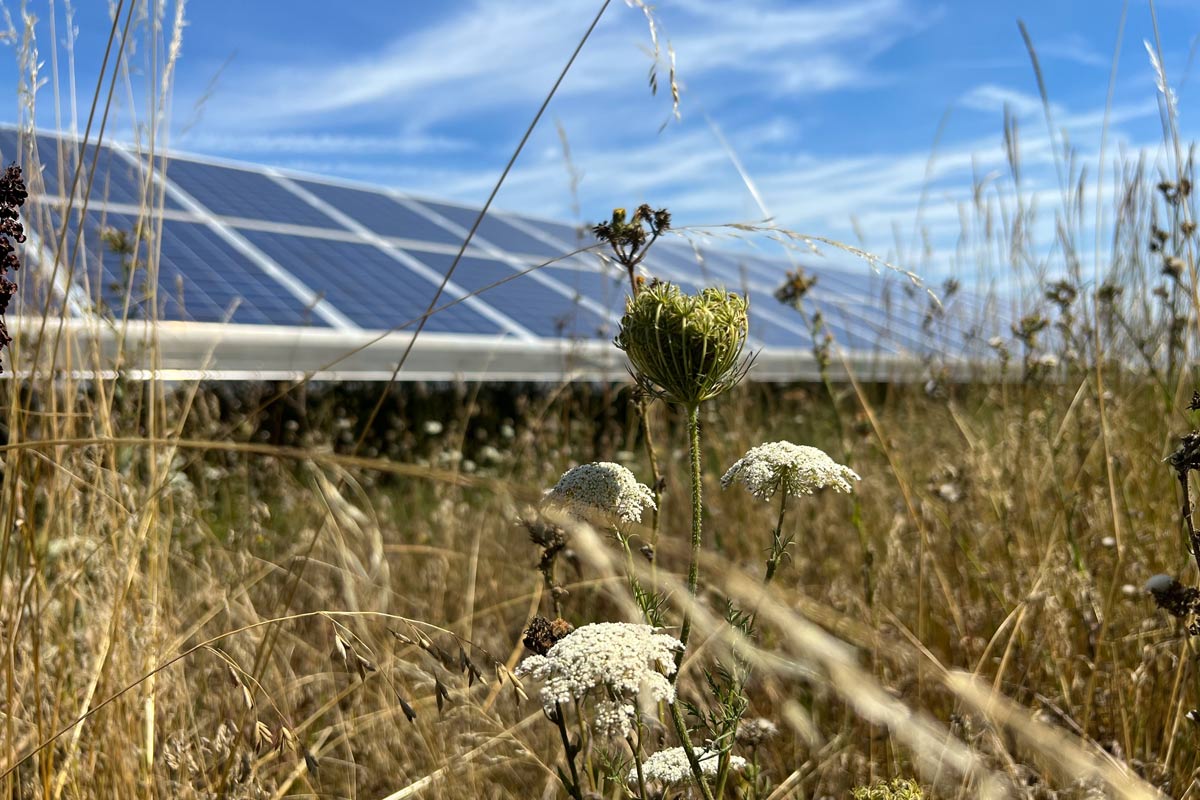
Interesting facts about agrivoltaic systems
Agri-photovoltaics: Sustainable synergies in agriculture and solar energy
How can agricultural land be used simultaneously for its original purpose (e.g. food and fodder production or animal husbandry) and to generate solar energy? Agri-photovoltaics (Agri-PV) offers an advanced solution that makes this balancing act possible. In this article you will learn how agrivoltaic complements agriculture and what impact it has on renewable energy production.
The most important facts at a glance
The most important facts at a glance
- Agri-photovoltaics combines agricultural use and electricity generation by photovoltaic systems on the same area, creating synergies and increasing land use efficiency.
- Agri-PV can be integrated into a wide variety of agricultural areas. In arable farming, on grassland, in special crops and in fruit growing, among others. Various technologies enable maximum synergies between agriculture and energy production.
- Regulatory frameworks such as the Renewable Energy Sources Act (EEG) support the integration of Agri-PV into agricultural areas, for example by providing remuneration and subsidies for promotion and thus contributing to sustainable energy and food production.
Agri-photovoltaics: A win-win situation for agriculture and energy
Agri-photovoltaics (Agri-PV) is the simultaneous utilisation of land for agricultural crop production and electricity generation using photovoltaic systems. This combination improves energy efficiency and creates synergies between agriculture and solar energy without compromising food production.
It represents a win-win situation that benefits both agriculture and the production of renewable energy by utilising agricultural land for crop production and energy generation at the same time.
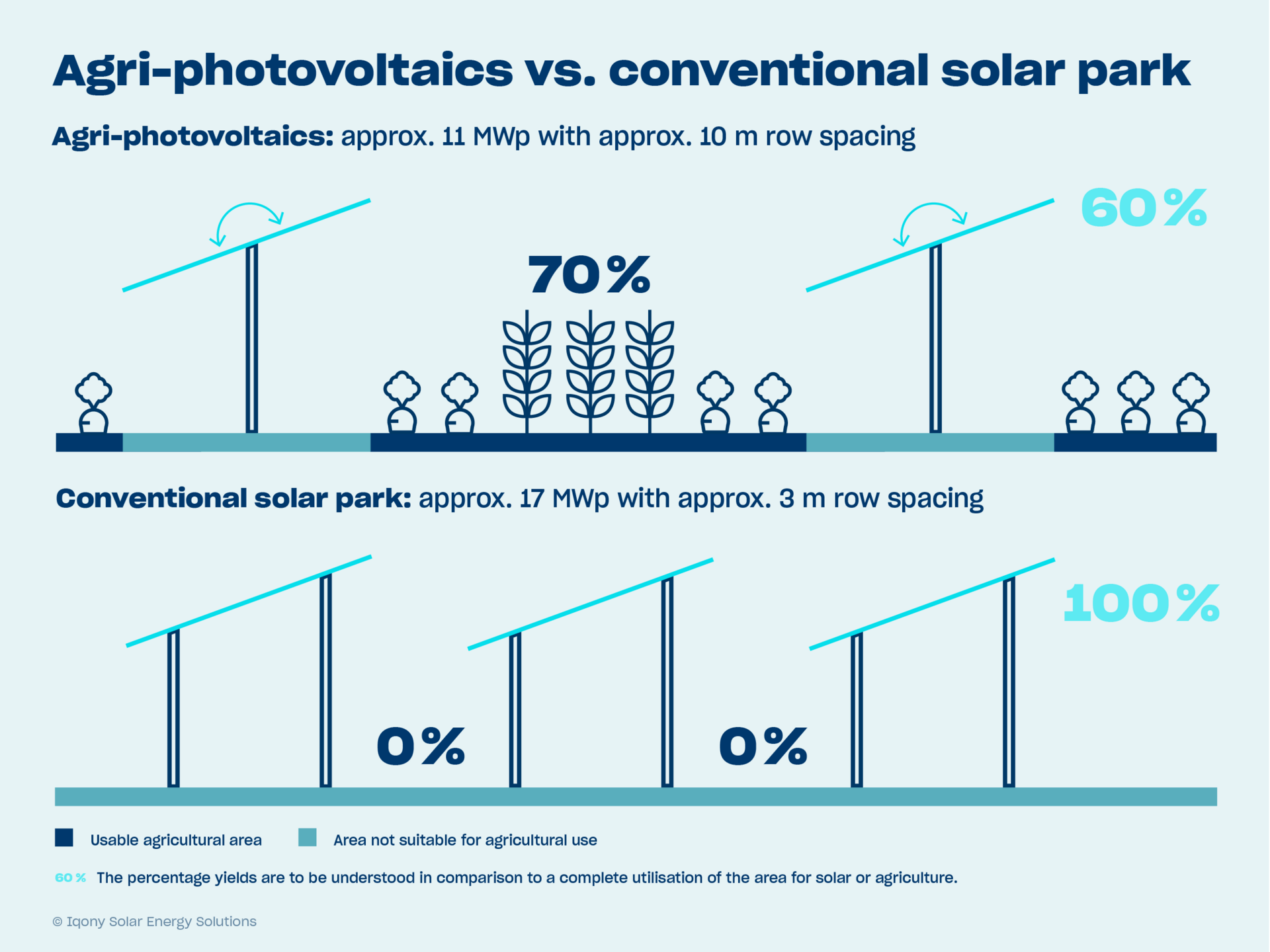
Percentage yields of an agrivoltaic system compared to a conventional solar park.
Agri-PV in a global context
Agri-photovoltaics is a global trend that has gained in importance worldwide over the last five years. With around 14 GW of installed capacity worldwide and a forecast technical potential of 1,700 GW in Germany alone, agrivoltaics has the ability to secure food and energy supplies in a sustainable manner.
Countries such as Japan, China and some US states began promoting Agri-PV back in the 2010s, laying the foundations for its successful integration into domestic agriculture.
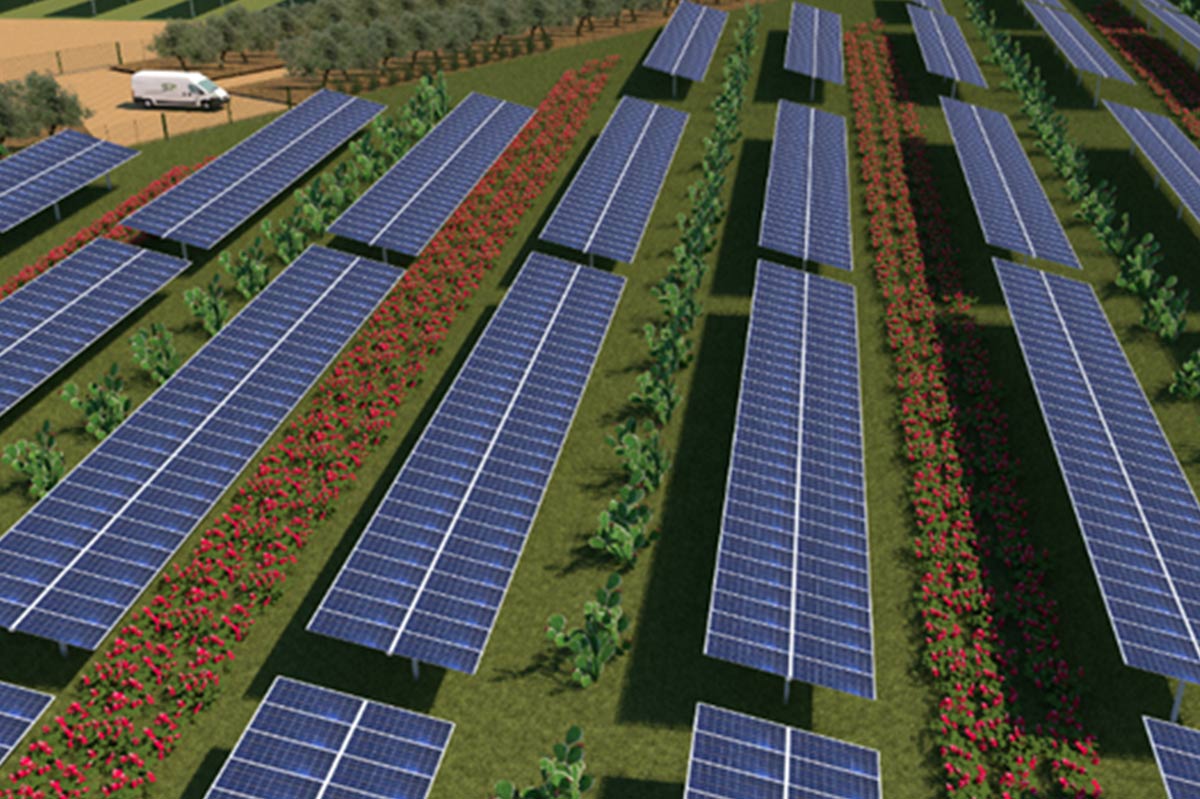
An illustration of an agri-PV system installed for dual use on agricultural land.
The potential at a glance
- Sustainable agriculture: Agriculture can be made more sustainable with agrivoltaics, as the modules reduce evaporation and protect against extreme weather conditions. With increasing electrification of machinery, farmers are also becoming less dependent on fossil fuels.
- Energy generation: Agri-PV systems offer the potential to generate significant amounts of clean energy, helping to reduce CO2 emissions and making an important contribution to the energy transition.
- Land use efficiency: The combination of solar energy generation and agriculture enables more efficient utilisation of limited agricultural land.
- Diversification of income sources: For farmers, the integration of agri-PV offers the opportunity to tap into additional sources of income by generating both electricity and agricultural yields.
- Promoting biodiversity: Due to their design, agrivoltaic systems create many small sites and are particularly suitable for extensive farming methods such as organic farming.
- Problem-free dismantling of the system: After the service life of the PV system (approx. 30 years), the solar modules can be recycled and the area can be fully utilised for agriculture again without leaving any residue.
Challenges of agrivoltaics
Despite the enormous potential of Agri-PV, there are also challenges that need to be overcome.
One of the biggest challenges is to increase the acceptance of agrivoltaics in agriculture, as aspects such as economic efficiency, land utilisation and integration into agricultural operations are important. The economic viability in particular has so far meant, that almost exclusively research and demonstration plants have been built in Germany. In addition, for many years there was a lack of standardised specifications and definitions that would set a standard for effective area-wide promotion.
Last but not least, farmers are sceptical about Agri-PV as they are not sure whether they will be able to continue farming the land or whether they will have to make new investments first. There is also uncertainty regarding liability issues, such as damage to the photovoltaic system caused by the farmer.
The technology also places high demands on the technical implementation and planning of the systems. In particular, integration into agricultural processes must be taken into account in order to ensure the main utilisation of agriculture. The selection of suitable technology and the realisation of feasibility studies are decisive steps in the implementation of Agri-PV projects. This is because the way in which solar modules are installed in agri-PV systems significantly influences the efficiency of the systems.
The alignment of the PV modules can be fixed or adjustable so that they can be rotatable depending on space requirements or weather conditions (see illustration). A basic distinction can be made between systems with low and high elevated modules.
The diagram above shows a fixed Agri-PV system. Plants can be sown between the rows of modules and under the module tables. The bottom row schematically shows how tracking modules work, which follow the position of the sun during the course of the day but can also be moved horizontally or vertically at the touch of a button. This provides more space for agricultural machinery in particular.
Integration of photovoltaics in various agricultural areas
Agri-PV can be used in various agricultural sectors.
1) Agri-PV in arable farming and grassland
Agri-photovoltaics can also be used in arable farming and grassland to optimise land use and increase energy production. In this area, agrivoltaics offer protection against extreme weather conditions such as strong solar radiation and wind. According to Fraunhofer ISE, agrivoltaics is therefore particularly suitable for crops such as forage species (e.g. clover grass) or leafy vegetables (e.g. lettuce).
2) Agri-photovoltaics in special crops and fruit growing
In addition to arable farming and grassland, Agri-PV can also be integrated into speciality crops and fruit growing to provide additional protection against extreme weather conditions (e.g. cold, rain, hail, strong sunlight) and increase energy production. Berry bushes and fruit trees such as apples are particularly suitable for the integration of Agri-PV. Other suitable speciality crops include wild garlic, asparagus and hops.
3) Eco-PV as a special form of agrivoltaics
In principle, the two approaches Agri-PV and Eco-PV are very similar: the principle of using an area for energy generation and plant production at the same time is identical. However, in contrast to agri-PV, eco-PV is about flowering meadows between the solar modules and less about harvesting feed or food for agriculture. The area between the solar parks is thus left to nature and can develop undisturbed, which can also offer enormous advantages for agriculture.
The undisturbed development of plants and animals around the solar modules creates new habitats. This promotes biodiversity to a high degree. Through the growth and diversity of insect species, agriculture in turn benefits from increased pollination in nearby fields. The area itself can recover in peace during the lifetime of the solar system.
With eco-photovoltaics, the maintenance of the solar park is therefore largely left to nature. For example, additional sheep grazing on the area can ensure that plants do not grow over the modules and shade them. Natural green cuttings and fertilisation are thus guaranteed.

As a special form of agri-PV, eco-PV leaves the space between the rows of modules to nature
4) Agri-PV including animal husbandry
In future, there will be an official standard for the combination of livestock farming and solar energy generation: DIN SPEC 91492:2024-06, which already defines requirements for the dual utilisation of an area in the form of livestock and solar modules. The DIN SPEC will be published in June 2024 in Germany. Among other things, the requirements for planning, operation, monitoring and quality assurance of the PV system will be defined. For example, the light intensity and distribution under the PV modules must be adapted to livestock farming. The system must also be protected from damage by livestock.
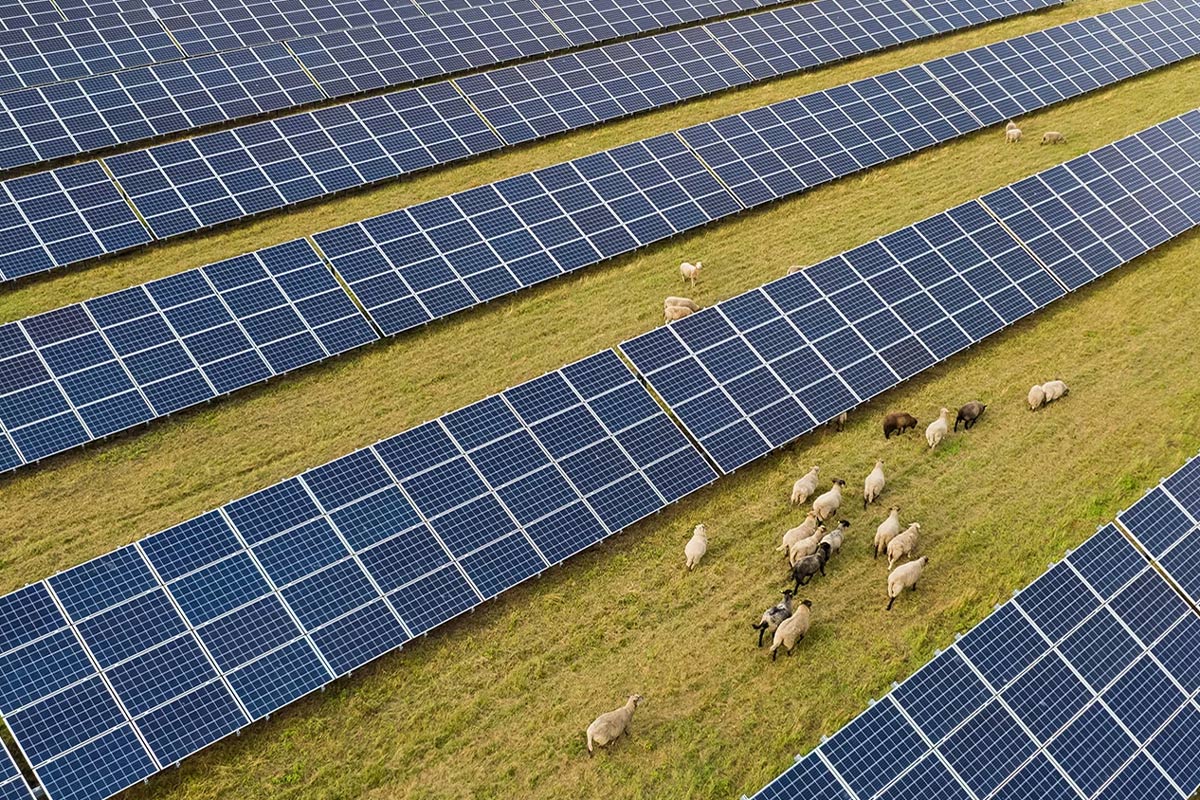
Agri-PV as a combination of solar energy and livestock farming.
Environmental aspects of agrivoltaics
Agri-photovoltaics not only offers advantages in terms of energy generation and agriculture, but also contributes to environmental protection and climate resilience. Similar to normal ground-mounted systems, agrivoltaics can also strengthen biodiversity and reduce CO2 emissions.
A. Agri-PV and biodiversity
Biodiversity can be promoted through the implementation of agrivoltaics. A study by the Bundesverband Neue Energiewirtschaft (BNE) has taken a closer look at the synergy effects between ground-mounted photovoltaic systems and the preservation of local flora and fauna. The result? Ground-mounted photovoltaic systems not only generate green electricity, but also provide habitats for plants and animals, which are protected from external influences. Studies have shown that this effect is particularly strong in agrivoltaic systems with tracker modules.
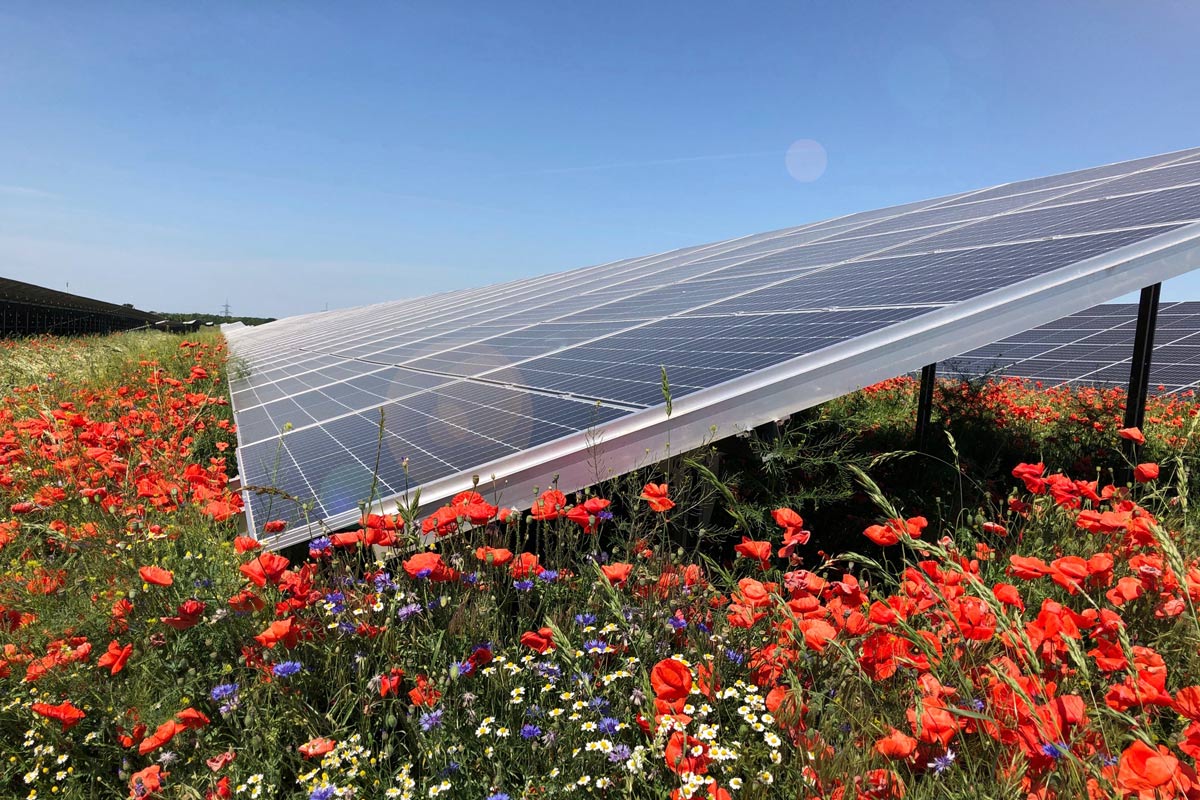
B. Climate protection and CO2 reduction through Agri-PV
Agri-PV contributes to the reduction of CO2 emissions and climate protection by promoting renewable energies and minimising land consumption.
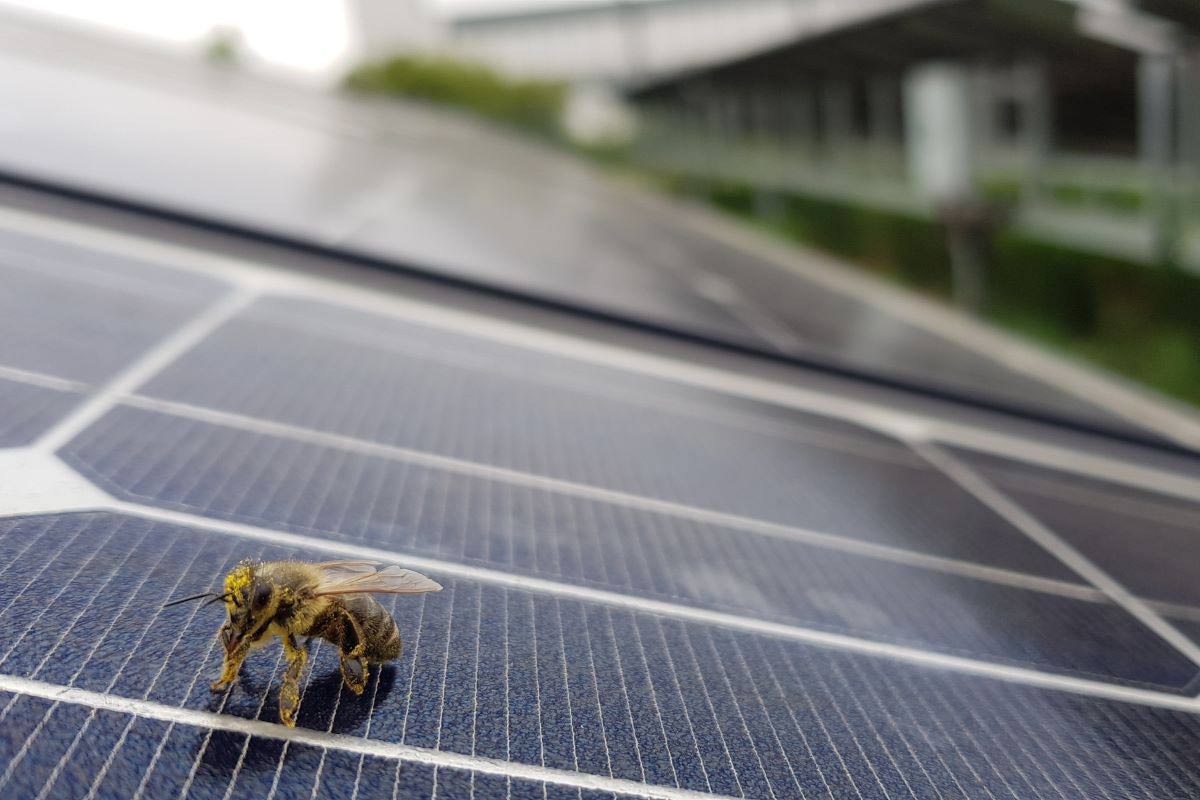
Further advantages of agrivoltaics
In addition to the environmental aspects, agrivoltaic systems have other advantages to offer:
• Protection against hail, frost and drought damage
• Increasing the wind load of the system
• Reduction of solar radiation
• Improvement of growing conditions through better microclimate
• Contribution to resilience to climate change
Summary
Agri-photovoltaics has the potential to fundamentally transform agriculture and energy production. It creates a win-win situation by offering farmers the opportunity to produce feed or food or keep livestock and generate renewable energy at the same time. If its significant land potential is utilised, it will play a decisive role in the energy transition and the promotion of biodiversity in the future.
For Iqony Sens, the advantages of this combined system are obvious. That's why we also develop, plan and build your solar system as an agrivoltaic system, giving your feed, animals and solar modules a shared home for many years to come. Would you like to benefit from the advantages of agrivoltaics? Then find out more here.
Images: Iqony Sens
Published: 8 May 2024
FAQ
What counts as Agri-PV?
Agri-PV counts as the simultaneous use of land for agricultural animal husbandry and crop production and PV electricity production. In agrivoltaic systems, agricultural activity must still be possible and around 2/3 of the yield of a reference area must be achieved.
How expensive is an Agri-PV system?
The installation of an agri-PV system can be expected to cost roughly 500 to 1,000 euros/kWp, but usually 700 to 800 euros/kWp. In addition, agri-PV can help to utilise the land potential efficiently and is generally more cost-effective than small photovoltaic roof systems on a limited area.
Where is Agri-PV permitted?
Agri-PV systems up to a size of 2.5 ha are also permitted in outdoor areas without a B-plan if they are located in spatial or functional proximity to the agricultural operation. There is no further privilege at national level. There are numerous special regulations regarding ground-mounted PV on agricultural land at federal state, regional and municipal level. Increasingly, agrivoltaic systems are being taken into account in control concepts and criteria catalogues of municipalities and formulated as a positive criterion. In principle, however, there is no privileged status for PV systems in outdoor construction areas. The construction of an FFPV generally requires an amendment to the land-use plan in conjunction with the preparation of a land-use plan.
Free area available?
We lease your area and implement photovoltaic systems.
Lease your land for photovoltaics and build solar parks for the energy transition. From a size of more than five hectares, Iqony Sens will realise your PV project and provide you with a fixed income for the next 30 years.

